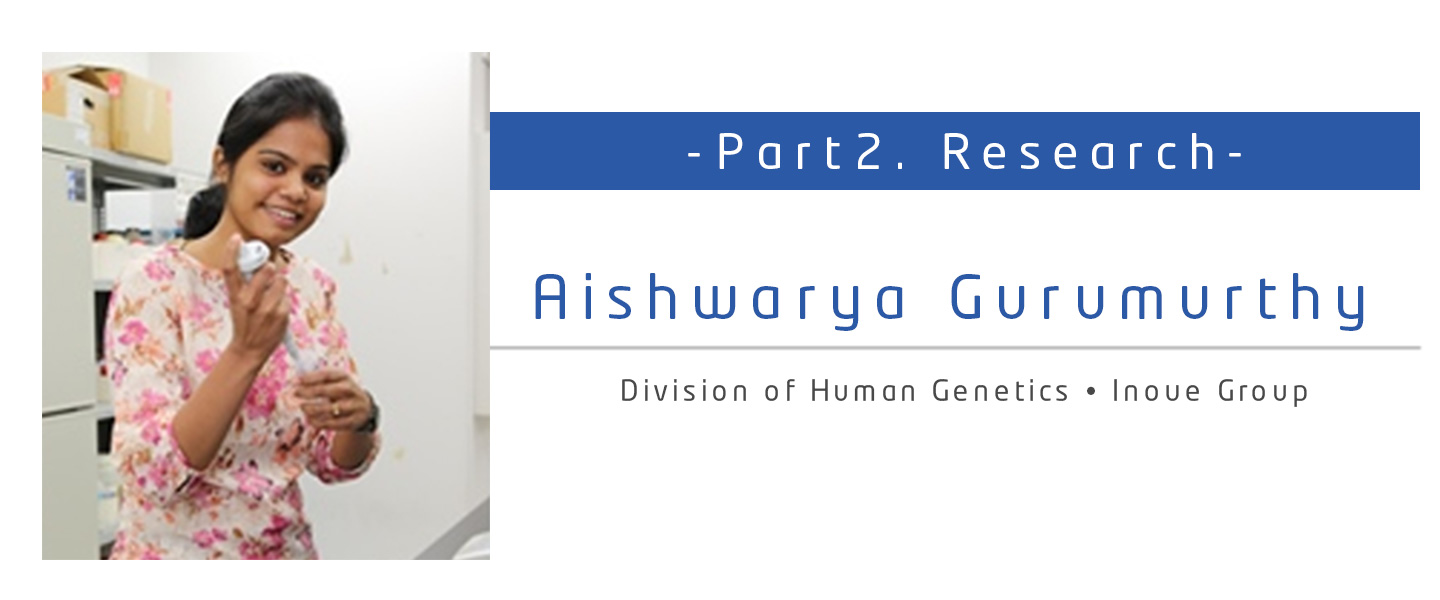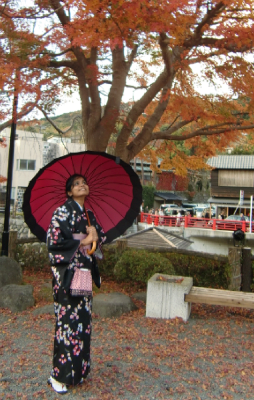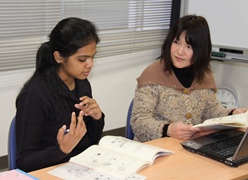Ms. Aishwarya Gurumurthy

Finding relation between gene expression networks and diseases
Question 1 Would you mind to explain us your research aim?
Biological system in human bodies is controlled by gene expression networks. When we try to understand cancer and rare genetic diseases, it is crucial to find out a mechanism of RNA regulation and to link genotypes with phenotypes. In order to understand relation between gene expression networks and diseases, I research the whole genome RNA expression by RNA sequencing using Next Generation Sequencing.
For instance, Cowden Syndrome is a rare autosomal dominant disorder that is characterized by multiple hamartomas and an increased risk for various kinds of cancer. Germ line mutation of tumor suppressor, PTEN, is seen in 80% of Cowden Syndrome patients. This gene located at 10q23.3 antagonizes the phosphoinositol-3-kinase / Akt pathway. Proper PTEN signaling leads to G1 cell cycle arrest or apoptosis.
Although the PTEN mutation has been generally recognized in Cowden Syndrome, in the case of our Cowden disease family, no notable CNV (copy number variation) or SNV (single nucleotide variant) of the gene and other candidate genes was not thus far detected. Then the question arises – “What is causing the Cowden Syndrome?”
In order to answer this question, RNA sequencing was done on iPS cells obtained from the patient sample. The reason why I did it was to find out which of the gene’s expression has been up or down regulated.

As a result of sequencing, the gene expression profile shows the up regulation in the expression of ITGA11 and FZD2 gens both having a role in evading apoptosis and causing cancer. ITGA11 seems to be antagonizing the tumor suppressor PTEN although I don’t consider them as candidate genes. So I need to study more iPS cells differentiated from the patients.
My other interest is relation between “gene desert” region and some diseases. Using 3C technology (Chromosome Conformation Capture), we can analyze the way distant regulatory elements regulate target genes resulting in formation of chromatin loops.
Chromosomal locus, 9p21 is an important locus associated with IA (Intracranial Aneurysm), CAD (Coronary Artery Disease) and other vascular disease. Genome wide association studies (GWAS) have identified SNPs that are correlated with such diseases. 9p21 has been known to be “gene desert” region housing around 33 enhancers.
I would focus on the regulatory role of this gene desert region on the genes and their expression that eventually could lead to develop IA. The long distant interaction between the regulatory element and the target gene can be studied using 3C technology whereas RNA Sequencing can determine the gene expression.
Hopefully this can provide us more to understand the landscape of the 9p21 locus.
Question 2 How did you know NIG?

Earlier, in India, I was working under Dr. Lakshmi Rao in Centre for Cellular and Molecular Biology. She visited NIG on a business trip. When she came back, she told me that she was truly impressed with facilities and research carrying out at NIG. That’s how I came to know about NIG and I was really interested in working here.
Question 3 What is a merit of working/ studying at NIG?
NIG has world-class facilities. Researchers are free – I mean, so many options are given. I can research whatever I want to try. If I need something for my experiment, anything is available here.
Not only you can do research with the most advanced techniques, but we also have lectures and seminars by researchers and scientists from all over the world – great learning opportunities for me. Being such a world-renowned Institute, I believe that working here at the start of my research life will surely help me reach heights.
As for communication- before I came here, I was a little scared whether people would understand me or I would understand them. But now I feel it wasn’t any problems within NIG.
I am also given a free Japanese lesson once a week. When I go shopping or traveling, I need to know some basic Japanese phrases. Being a vegetarian, it is important to know what are inside in foods so I have to ask shop staffs what contains in Japanese and to understand their answers. I learn so much in the Japanese class, which really helps me to communicate outside.
Question 4 What is your impression of Mishima city?
I’m from Hyderabad, India. It’s really noisy there. So much pollution, cars and people…stuff like that. But Mishima is really quiet and nice. It is quite a contrast to where I have been living many years. I really love the nature – lush green fields and clear rivers. If I don’t want to go very far, I’d walk along Genpei Gawa (the River Genpei).
I enjoy beauty of Mt. Fuji everyday while cycling to work. It is far from the hustle-bustle of the city and its view is just breathtaking.
Being a vegetarian, I have not tasted Japanese cuisine so much, but Indian restaurants in Mishima are my choice when I miss our foods. I found three Indian restaurants in such a small town!
Question 5 How do you spend your day off/ holiday?
I have been many places. While my husband was working in Hamamatsu, we visited lots of places together. Japan is an amalgam of tradition and modernity. I love Japanese style gardens, shrines, mountains as well as modern architecture like skyscrapers.
Personally Nikko, Tokyo and Hiroshima are the three best places that we have been to.
Oh, never forget Fuji-Q Highland! It is really exciting. My husband and I love rollercoasters. Of course, there are rollercoasters in India, but they are not as twisted or fast as Japanese ones.

I’m self-learning origami from the Internet. It’s difficult but a good fun. A few of my colleagues show me how to do and I try it at home, but it’s not the same. I think I need longer nails to fold a paper precisely. I try to make origami flowers such as lilies, dahlias or roses because I really like flowers. I attach my works to the greeting cards. [study] Learning Japanese language is also my passion. I study it every day. It is interesting to know history of Kanji (Chinese characters). I took a JLPT N5 (Japanese Language Proficiency Test Level 5)last December and passed. It was a great experience indeed!
Question 6 What would you like to achieve in the future?I would like to do more research and to find out interesting results. I hope my husband’s company will send him to Japan again so that I can continue my research at NIG as I like here very much. And I want to speak Japanese more fluently and to pass an advanced level of JLPT.
transcription & translation : Chikako Miura (General Affairs/Education Team)
Back














